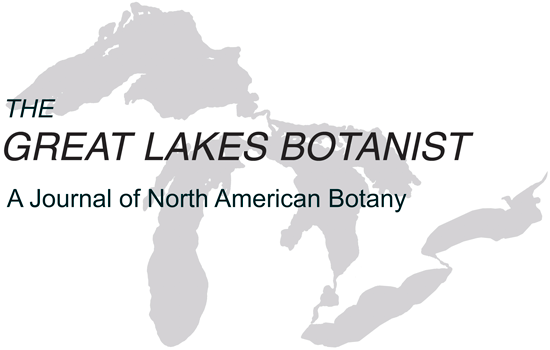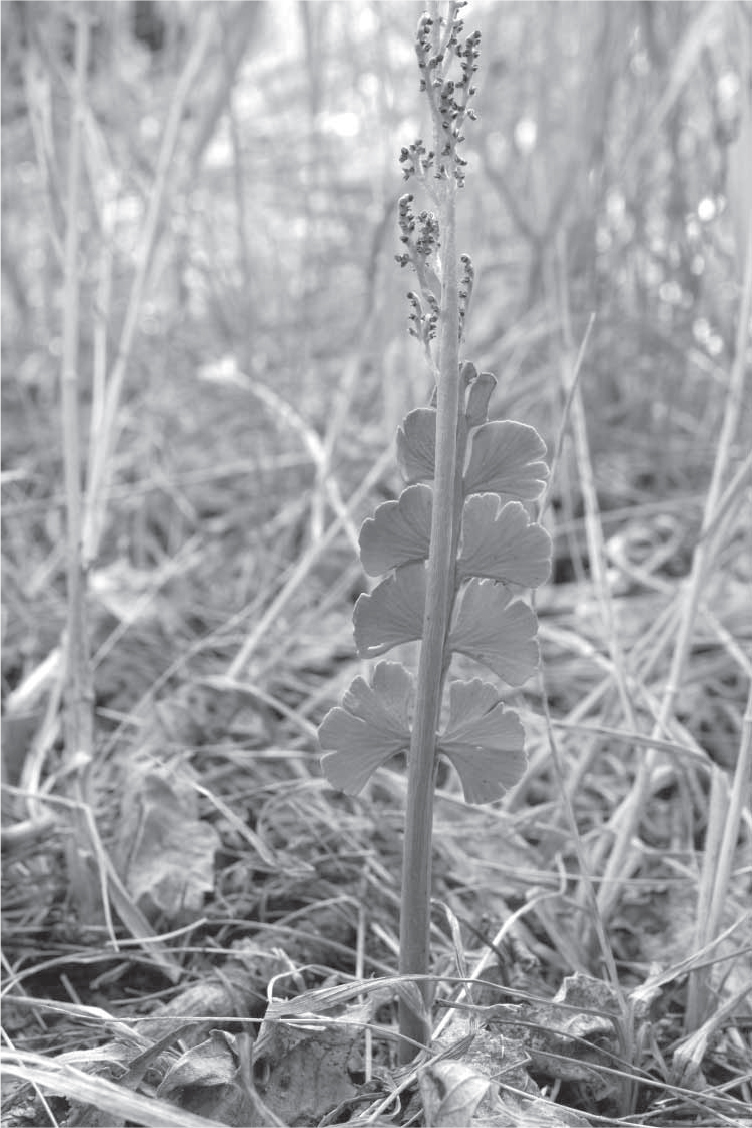Significance of Report.
Populations of Botrychium crenulatum discovered in northwestern Minnesota since 2011 are over 1000 km disjunct from the nearest previously known populations; they occur in two distinctly different kinds of habitat where they exhibit two extremes of morphology.
Previous Knowledge.
Since its description in 1981, Botrychium crenulatum W. H. Wagner (Dainty moonwort) has been found to be widely distributed in western North America from southern California and Arizona to British Columbia and Alberta. Even so, the species is less common than most species of Botrychium (moonworts) throughout this range. It is the most hydrophilic of the moonworts, occurring in saturated soils of spring seeps, riparian margins, and hardwater fens (Farrar, 2011). Although it was originally presumed to be limited to western North America, Farrar (2011) noted one disjunct occurrence that was then newly discovered in June 2011 in Itasca County, Minnesota, and noted others in the James Bay region of Ontario. More recently, he reports abundant populations in western Newfoundland where it can be the most common moonwort (Farrar, personal communication).
Botrychium crenulatum was first collected in Minnesota by Otto Gockman in Chippewa National Forest, Itasca County, north of Lake Winnibigoshish. The habitat is the seasonally saturated marshland margin of a northern mixed hardwood forest (Figure 1). The plants were growing in nearly full shade under a canopy locally dominated by Fraxinus nigra Marshall. They are small and with a very delicate habit (Figure 2). Other moonworts at the site include B. minganense Vict., B. ascendens W. H. Wagner, B. pallidum W. H. Wagner, and, in mixed hardwoods in close proximity, B. mormo W. H. Wagner. This is a common habitat in Chippewa National Forest, but ongoing surveys of similar sites have yet to find additional populations of B. crenulatum (Bobby Henderson, personal communication).
Discussion.
In 2015 and 2017, I made collections from two populations of Botrychium crenulatum in Lake of the Woods and Roseau counties. The two sites are separated by approximately 31 km and are approximately 160 km northwest of the Itasca County site. They are roughly equally distant, at over 1000 km, from both the nearest western distribution of the species and the James Bay region occurrences. These sites are on the well-drained, sandy soils of old periglacial Lake Agassiz beach ridges that cross the landscape between large peatland basins. Due to an unusual landscape history described in North et al. (2013) and MacFarlane and MacFarlane (2021), the most productive Botrychium habitats here are now on old-field and homestead sites abandoned precipitously in the 1930s. This is true for all species of Botrychium known to occur here. This savannah region is marginally north and west of the known ranges of the forest moonwort species, B. mormo and B. angustisegmentum (Pease & A. H. Moore) Fernald. These sites are mesic to seasonally dry, which may modify what we consider suitable habitat for B. crenulatum in Minnesota. Botrychium crenulatum specimens were confirmed by Don Farrar on site visits, June 25 and 26, 2022, from an old-field site in southeastern Roseau County (Figure 3) and a homestead site in southern Lake of the Woods County (Figure 4).
On these sites, Botrychium crenulatum occurs in genus communities of at least three species, most abundantly B. neolunaria Stensvold & Farrar, B. minganense, and B. pallidum. Populations are in partial shade under small Populus tremuloides Michx., mature Acer negundo L., or dense clumps of Bromus inermis Leyss. These habitats produce very robust plants (Figure 5) compared to the Itasca County plants, which suggests that these may be more favorable habitats for Botrychium crenulatum in Minnesota. Due to what was presumed an unusual, even inhospitable, habitat for this relatively hydrophilic species, the very robust habit, and the co-occurrence of two morphologically similar species, B. neolunaria and B. minganense, specimens from the Lake of the Woods County population were initially overlooked as aberrant specimens of B. neolunaria. Then the Roseau County population was found, which had a greater proportion of B. crenulatum and with a very consistent morphology. This was the drier of the two sites. Figure 6 is a detail of two pressed specimens from each of these two sites. There are other mixed populations of B. neolunaria and B. minganense I have collected from in this region since 2013 that could include B. crenulatum as well. Collections from these populations were not sufficiently mature to reliably distinguish between B. neolunaria and B. crenulatum. These sites will be revisited to check specifically for B. crenulatum.
Detail of mature pressed specimens of Botrychium crenulatum from collections in north-northwestern Minnesota, June 26 and 27, 2022. Two specimens on the left are from the Hogsback site, Red Lake Wildlife Management area, Lake of the Woods County. Two specimens on the right are from the Hayes Lake site, Hayes Lake State Park, Roseau County. Photo by Richard Haug.
The Minnesota occurrences and those in the James Bay region and in western Newfoundland suggest an earlier, more continuous post-glacial distribution that was trans-continental. Such a distribution may persist across central Canada and may include habitats not previously considered suitable for this species.
Diagnostic Characteristics.
Botrychium crenulatum is described in Wagner and Wagner (1981). Additional observations were offered by Don Farrar during field site visits in 2022. Two moonwort species in Minnesota may have basal pinnae with a span of nearly a half circle, Botrychium neolunaria and B. crenulatum. Specimens of B. crenulatum with narrower pinnae may look much like B. minganense. These three species are both similar enough and variable enough that the differences between them may be subtle. Thus, the characteristics should be considered more as population characteristics rather than necessarily applicable in every specific instance to every individual. Robust specimens of B. crenulatum from northwestern Minnesota look much like B. neolunaria, while daintier specimens like the Itasca County plants may more closely resemble B. minganense.
Botrychium crenulatum in Minnesota typically has a stalked trophophore and slightly ascending pinnae with crenulate margins. The pinna pairs are usually well separated as compared to B. neolunaria, which commonly has more proximate, or even overlapping, pinna pairs. In B. neolunaria, subsequent pinna pairs are often increasingly ascending from the first to the third pair, while in B. crenulatum, they are more consistently ascending throughout. Robust specimens of B. crenulatum may have lower pinnae that are deeply incised up to half their length into three to five or more sections, each usually with somewhat crenulate margins (Figure 6). At maturity (i.e., at spore release), the sporophore stalk of B. crenulatum is approximately the same length as the trophophore, which is shorter than is typical for B. neolunaria. The sporophore branches of B. crenulatum occupy approximately half the length of the sporophore and are spreading, while those of B. neolunaria are more crowded into the upper third of the sporophore and are more ascending. The sporophore branches of B. crenulatum commonly twist (Figure 5), directing the sporangia outward or downward.
Botrychium minganense shares the traits of a stalked trophophore, well separated pinna pairs, consistently ascending pinnae (although significantly more so than B. crenulatum), and sporophore stalks approximately equal to the length of the trophophore. The pinna margins in B. minganense tend to be entire to lobed, but are notoriously variable.
Specimen Citations.
MINNESOTA, Itasca County, Chippewa National Forest/Leech Lake Indian Reservation, south of Hale Lake, T147N, R28W, Sec. 25. A sparse population in a 10 × 30 m area in seasonally saturated marshland margin of northern mixed hardwood forest, in full shade, under canopy locally dominated by Fraxinus nigra. Associates include Botrychium minganense, B. ascendens, and B. pallidum. June 30, 2011, Otto Gockman 00049 (MIN) 53607[1305435].
MINNESOTA, Roseau County. Hayes Lake State Park. About 30 km south-southeast of Roseau, south of County 4. T160N, R38W, Sec. 32. A single 6 × 12 m patch, with an estimated 50 plants, in old-field in sparse grasses on sandy soil under a single mature Acer negundo. Associates include Botrychium minganense, B. pallidum, B. neolunaria. June 20, 2017. Malcolm MacFarlane 765 (MIN) 958749 [1305591].
MINNESOTA, Lake of the Woods County. Red Lake Wildlife Management Area, south-southeast of Norris Camp, and south of Hogsback-O’Brien Forest Road. T159N, R35W, Sec. 2. A single 10 × 30 m patch in a homestead site, with an estimated 40 plants, in dense Bromus inermis with scattered small Populus tremuloides. Associates include Botrychium minganense, B. neolunaria, and B. pallidum. June 6, 2015, Malcolm MacFarlane 593 (MIN) 948765[1291656].
Acknowledgments
I would like to thank Don Farrar, who examined many specimens and visited all three Minnesota field sites. Welby Smith and Richard Haug gave freely of time and talents on multiple occasions. Thanks also to Bobby Henderson, who tracked phenology at the Chippewa National Forest site and escorted us there on several occasions, and to the Leech Lake Indian Reservation. The folks at Red Lake Wildlife Management Area, Gretchen Mehmel, Charlie Tucker, and Deb Beckel, made us welcome and comfortable over many seasons of field work in accommodations at Norris Camp. Special thanks to Rosemary, for her assistance and patience.
Literature Cited
Farrar, D. R. (2011). Systematics and taxonomy of genus Botrychium. Available at https://www.herbarium.iastate.edu/files/inline-files/Moonwort-Systematics.pdf. (Accessed August 2022).https://www.herbarium.iastate.edu/files/inline-files/Moonwort-Systematics.pdf
MacFarlane, M. B., and R. L. MacFarlane. (2021). Distributions of species of Botrychium (Ophioglossaceae) in north-northwestern Minnesota. The Great Lakes Botanist 60: 82–96.
North, M. R. et al. (2013). Beltrami Island land utilization project. Comprehensive conservation management plan. Minnesota Department of Natural Resources and U. S. Fish and Wildlife Service. Available online at https://files.dnr.state.mn.us/input/mgmtplans/beltrami_island/final-lupccmp.pdf. (Accessed July 2022).https://files.dnr.state.mn.us/input/mgmtplans/beltrami_island/final-lupccmp.pdf
Wagner, W. H. Jr., and F. S. Wagner. (1981). New species of moonworts, Botrychium subg. Botrychium (Ophioglossaceae) from North America. American Fern Journal 71: 20–30.






